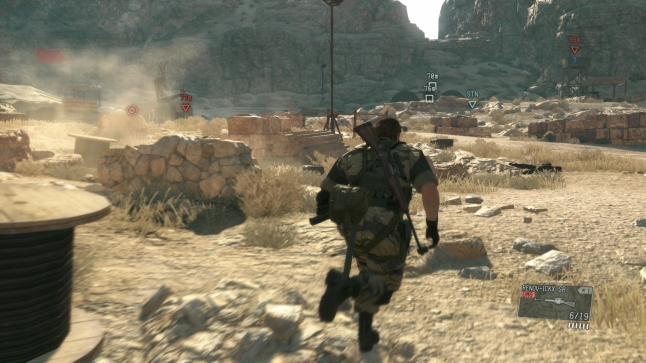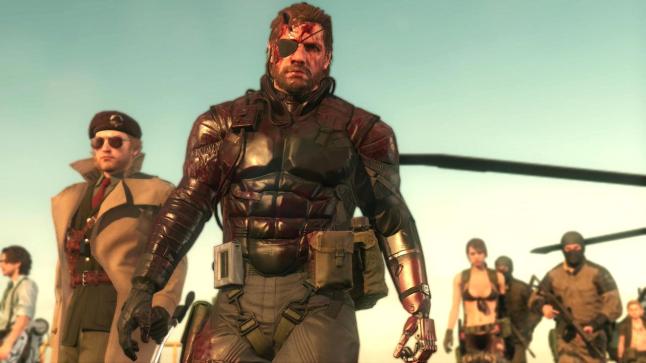THE CYCLE IS COMPLETE
I remember in 2009, when I went into Best Buy with 60 bucks in hand, looking for a game that I could have fun with over the summer. The pickings were rather slim, with nothing that I felt was interesting. Then, I stumbled upon the last copy of Metal Gear Solid 4: Guns of the Patriots. I thought to myself “Hmm, well there really isn’t anything else I like here, might as well just get this.” Little did I know that this decision would spark a passionate love for a saga that was established well before my birth. I have become engrossed with the lore and saga of Metal Gear. From Guns of the Patriot, my first Metal Gear game (and by far my favorite), to the emotional roller coaster of the saga’s prequel Metal Gear Solid 3: Snake Eater, to the 8-bit Metal Gear and Metal Gear 2: Solid Snake, and even the non-canon Snake’s Revenge, Acid, and Portable Ops, my friends can attest to my passion and love of this Saga. That is why I am more than honored, after finally completing this game 100%, to be giving a full review of the final entry into the Metal Gear Saga, Metal Gear Solid V: The Phantom Pain.
The bridging gap between the original Metal Gear released in 1996 (referred to as the beginning of the Solid Snake Saga) and Metal Gear Solid: Peace Walker released in 2010, The Phantom Pain follows Big Boss as he, Kazuhira Miller, and Ocelot, rebuild their Private Military Company to exact revenge on the Cypher Organization for the destruction of their Mother Base in the aftermath of Metal Gear Solid V: Ground Zeroes, which resulted in Big Boss falling into a nine-year coma. While the themes of race, the pain of loss (be it limb or friend), and the cycle of revenge and how it drives men to become demons are explored and presented beautifully not only through the story but the gameplay itself (depending how you play) it does sadden me that this particular story is by far the weakest in the entire Metal Gear Saga. What it lacks in story, it more than makes up for with stellar gameplay, mission structure, and base management! Add the PvP mode in the form of Forward Operating Base mode (commonly referred to as FoB) and a completely separated Multiplayer Mode; Metal Gear Solid V: The Phantom Pain is Kojima’s realized vision of the definitive Metal Gear Solid experience.

PART I: STORY (Potential Spoilers)
Taking place nine years after the events of Ground Zeroes, The Phantom Pain opens with Big Boss waking up from his coma in a hospital in Cyprus. After brief cut scenes showing the situation Big Boss is in (having 108 pieces of shrapnel enlarged into him and losing his left arm). You’re immediately throwing into a spectatical opening tutorial of basic controls. After being saved from an assassination attempt by Quiet, Snake and his rescuer, Ishmael, are forced to escape the besieged hospital. Snake is not only perused by X.O.F. (Cypher’s strike force), but also a demonic apparition of Colonel Vulgan (the main antagonist from Snake Eater). Snake is then rescued from Cyprus by his old rival Ocelot, and, after two weeks of intensive therapy, Snake is tasked with rescuing his second in command, Kazuhira Miller, from Soviet forces operating in Afghanistan. After this mission, the story takes a back seat to the gameplay. Outside a few cinematic moments, such as the introduction of Skull Face, and the impromptu rescue of scientist Huey Emmrich, to name a few, the story really doesn’t pick up until later in the first chapter. I can understand why this was done, as Snake needs to take up contracts in order build his new mercenary unit Diamond Dogs, but it just doesn’t do justice to the overarching plot. Even through half way through Snake changes focus from revenge to stopping Skull Face and his plans, it occasionally comes off at times as your stereotypical revenge plot. The second act of the game pretty much serves to tie up a lot of loose ends, such as the revelation of Huey’s betrayal that resulted in Snake’s coma, the mystery behind Paz’s survival of Ground Zeroes, Eli (who is a young Liquid Snake) and how he comes to hate Snake. However, there is one minor argument that I will make in regards to the game’s ending. Without spoiling it, a lot of people feel that the games ending was a rushed and a complete letdown. And in an unbiased opinion. I can understand why. My first time watching it, I also felt the same way. However, after watching it again, I have to say that this felt like the right to end the game. In my opinion it was Kojima (and to an extent, Big Boss himself) thanking the player for helping to support and create the legacy that is Metal Gear Solid, and that Big Boss is as much a part of our lives as we are a part of his.
Outside of one very heartfelt mission closer to the end, the story is your standard revenge story albeit with a few good twists. Those looking for more explanations and substance will have to rely on cassette tapes. Cassette tapes can be earned by completing missions and side ops, and honestly, this is where the true crux of the story is (think codec calls from all the other Metal Gear games, but optional this time.) This was done so newcomers wouldn’t be lost due to the massive amount of lore, while still giving diehard fans what they are accustom to.

Unfortunately, the voice performances are mostly hit and miss. Overall everyone does a rather solid job in their respective roles. (Even though David Hayter will always be Solid Snake in my eyes) Kiefer Sutherland does a great job as an aged and battle worn Big Boss with the lines he was given, Troy Baker does an impressive job as Ocelot, Robin Atkins Downs reprises his role as Kazuhira Miller, and it was great hearing Lori Allen reprise her role as The Boss. In addition, even though he makes no physical appearance, it was great hearing Major Zero again via cassette tapes after being absent from recent games. However, these performances are not without their faults. The Phantom Pain probably has the quietest Snake in history, as Kiefer Sutherland barley talks in the game. I can understand why Kojima has a quieter Snake, as he wants to show Snakes emotions through facial expression, as well as for the players to channel their emotions through Snake. This comes at a cost of a few really awkward moments of pure silence. It feels that a lot of the characters are waiting for Big Boss to respond, only to move on when they realize he isn’t going to say anything. This is also probably the tamest Ocelot as well. Ocelot’s character is irrational and unpredictable, always scheming having a taste for the dramatics, but in The Phantom Pain, he comes off as just a character that is there. Outside the revelation at the conclusion, the game sometimes comes off as he really has no place or reason to be there.
However, the themes presented in The Phantom Pain are a serious saving grace. The main theme throughout the game is revenge and how it drives men to become demons, and this is presented in many subtle ways. From Kaz’s obsession with crushing Cypher, Snake’s transformation throughout the game with the actions he carries out (there is actually one particular scene about mid-way through the game that is hard to watch due to the intensity and suspense of what Snake does), Vulgan coming back to settle the score with Snake after the events of Snake Eater, to Quiet wanting peace from being treated like an outcast, everyone in this game has an underlying motive for revenge (save Ocelot). Even Skull Face, after fully understanding his backstory, has a somewhat understandable reason for doing what he does. Another main theme throughout the game is the pain that comes from losing something dear to you, be it your memories, your body, the legacy you built, or your friends and brothers in arms. This pain can be felt by everyone in the game, and in a sense allows you to understand why certain characters are driven to revenge. Particularly, I found Paz’s side mission to be the most heartfelt and touching, as it in a sense forces Snake to come to terms with what happened at the ending of Ground Zeroes. Even seeing Quiet suffer the pain of having her voice taken from here and her concluding mission definitely echoes a powerful pain many people go through in real life. Indeed, these two themes are what help carry the story.

PART II: GAMEPLAY
The Phantom Pain is Open World, Action/Adventure, 3rd Person Shooter. Snake will select a mission, travel to the mission area, and from there anything is possible. Due to the new open world aspect of the game, players are free to infiltrate mission areas from any point in the game. Those who have played Ground Zeroes will feel right at home with the controls, as nothing has really changed, but rather refined. However, gameplay isn’t just limited to this. Outside of the story missions, players are free to partake in 180 side ops missions and roam the open maps of Afghanistan and the Angola-Zaire boarder regions, collecting resources, taking control of outpost, and capturing exotic animals. The Fulton Recovery System makes a return from Peace Walker, and not only is limited to enemy soldiers this time, as resource containers, anti-air guns, jeeps, trucks, and even exotic animals can be fultoned back to base.
The Base Management System also makes a return from Peace Walker, but this time around it can be fully explored by the player character. While on Mother Base, players can interact with staff recruits to raise morality, and even trigger special cut scenes and side missions. The base is fully customizable as well. You can select what paint scheme you would like to have, as well as customizing your own emblem for your base.
Perhaps the most useful tool in the game (outside the cardboard box) is Snake’s IDroid. This device can be used to manage most aspects of gameplay. Players can construct more platforms for Mother Base, develop more equipment and items to use in the field, call in supply drops, send soldiers on dispatch missions, and even call in air strikes. However, all of this comes at a cost. As you complete missions and side ops, you will acquire GMP. GMP is needed for a majority of the aforementioned features (developing new weapons, calling in support from mother base, fultoning items and soldiers, etc.…). The game requires the careful management of your GMP and resources, as overspending will cause you to go into the red, causing staff and base morale to fully drop.

After completing a certain number of missions, you can supplement the single player game with the player vs. player Forward Operating Base system. An online expansion of single player, the FoB mechanic allows you to develop other mother bases. This comes with the benefit of being able to house more staff members and collect more resources. The catch is, your online mother base is susceptible to being infiltrated by other players. To defend against this, you will have to make sure your base is well equipped with security measures. You can also invade other players’ FoB as well to steal staff members and resources. Players have to be careful however, as becoming detected during an invasion will open up your FoB for direct retaliation. Aside from this, there is a dedicated multiplayer mode. Metal Gear Online returns in its third iteration, and from what time I have spent with it, it’s a great way to truly test how well you understand the mechanics. This isn’t your standard multiplayer game however, as the success of the team-based multiplayer modes will rely heavily on cooperation from teammates, as well as taking a slower, more tactical approach to a situation. This is more than true for the games feature mode Cloak and Dagger, where attacking players must work together in order to retrieve intel from an enemy base using only non-lethal weapons, while the defenders must set up a perimeter and defend the intel at all cost. Metal Gear Online 3 is a welcomed and refreshing break to your standard multiplayer games and is sure to keep your attention even if you haven’t completed the main game.
PART III: GRAPHICS/SOUND/CONTENT
The Phantom Pain run on Kojima’s in house Fox Engine, allowing for photorealistic detail to the environments, as well as character facial expression. The game runs noticeably better on the PS4 and XBOX ONE, but still runs amazingly well on last generation systems, pushing them to their limit. Very rarely did I ever run into lag with the game on my PS4, occurring a few times when I got into rather intense fire fights with enemy guards, particularly on the Afghanistan Map (likely due to the fact this map is the largest of the two available).
Harry Gregson-Williams returns along with newcomers Ludvig Forssell and Justin Burnett to produce some of the most amazing music in a Metal Gear game. and as always, Gregson-Williams lives up to expectations. The music immerses the player into the world, be it riding horseback into the Afghan wilderness or traversing the thick of the African jungles. Even during cut-scenes the score adds an amount of uncertainty to the current situation, and even hones in on the themes of the game.
All in all this game has a lot of content, with two fully open maps to explore, over 50 main missions and 180 side ops, along with a base management system, and Forward Operating Base extension, the single player campaign has well over at the least 200 hours’ worth of playtime if used to its fullest potential. Even if you just want to focus on beating the game for the story, you will still find yourself putting at the bare minimum 60+ hours into Phantom Pain. No matter how you play through this game, it is definitely worth the $60 price tag!!

CONCLUSION
Without a doubt I can say that Metal Gear Solid V: The Phantom Pain is truly the definitive Metal Gear experience. Despite having a weak story, the game more than makes up for it with amazing gameplay mechanics that are perfectly woven together and powerful themes and messages that will resonate with players long after they have completed the main missions. In a sense, it pains me to write this review, as it forces me to come to the realization that this is the final installment in a saga that I have grown to love and admire over the course of the six years. Everyone, from my friends to even my mom, knows how much I love this saga. And while it pains me to say goodbye, I can rest knowing that Kojima, after years of dedication to the story, was able to create by far the best Metal Gear Solid game, as well as the perfect missing link, that completes a well revered saga.
My Personal Score: 9.5/10
~Justin Noel

Loved the game just the story was a big let down. Damn you Konami!!
LikeLiked by 1 person
That sums up most of what I’ve heard. Amazing gameplay, just such a shame at that lost potential. It is still an incredible sendoff nonetheless – thanks for reading!
LikeLike